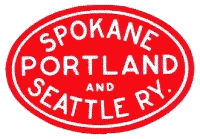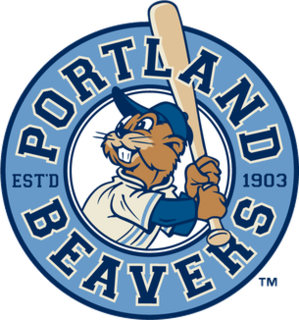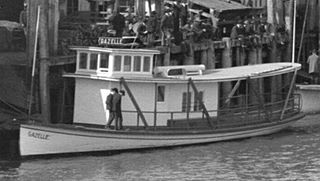
Moda Center, formerly known as the Rose Garden, is the primary indoor sports arena in Portland, Oregon, United States. It is used for basketball, ice hockey, rodeos, circuses, conventions, ice shows, concerts, and dramatic productions. The arena has a capacity of 19,393 spectators when configured for basketball. It is equipped with state-of-the-art acoustics and other amenities.

The Veterans Memorial Coliseum is an indoor arena located in the oldest part of the Rose Quarter area in Portland, Oregon. The arena is the home of the Portland Winterhawks, a major junior ice hockey team, and was the original home of the Portland Trail Blazers of the National Basketball Association. It has been included on the National Register of Historic Places in recognition of its architectural significance.

The Spokane, Portland & Seattle Railway (SP&S) was a railroad in the northwest United States. Incorporated in 1905, it was a joint venture by the Great Northern Railway and the Northern Pacific Railway to build a railroad along the north bank of the Columbia River. Remnants of the line are currently operated by BNSF Railway and the Portland and Western Railroad.

Ulysses S. Grant High School is a public high school in the Grant Park neighborhood of Portland, Oregon, United States.

Gill Coliseum is a multi-purpose arena in the northwest United States, located on the campus of Oregon State University in Corvallis, Oregon. Opened 73 years ago in late 1949, the arena has a seating capacity of 9,604 and is home to the Oregon State Beavers' basketball, wrestling, volleyball, and gymnastics teams. It is named after basketball coach Amory T. "Slats" Gill, who compiled a 599–392 (.604) record in 36 seasons—from 1928 to 1964.

St. Johns is a neighborhood of Portland, Oregon, United States, located in North Portland on the tip of the peninsula formed by the confluence of the Willamette River and the Columbia River. It was a separate, incorporated city from 1902 until 1915, when citizens of both St. Johns and Portland voted to approve its annexation to Portland, which took effect on July 8, 1915.
Portland, Oregon, United States, is home to three major league sports teams — the Portland Trail Blazers of the National Basketball Association, the Portland Timbers of Major League Soccer, and the Portland Thorns FC of the National Women's Soccer League. The city also hosts a wide variety of other sports and sporting events.

Burlington Northern Railroad Bridge 9.6 or BNSF Railway Bridge 9.6, also known as the Columbia River Railroad Bridge, is through truss railway bridge across the Columbia River, between Portland, Oregon, and Vancouver, Washington, owned and operated by BNSF Railway. Built by the Spokane, Portland and Seattle Railway (SP&S) and completed in 1908, it was the first bridge of any kind to be built across the lower Columbia River, preceding the first road bridge, the nearby Interstate Bridge, by a little more than eight years.

Portland, Oregon, has been home to many baseball teams, dating back to the 19th century.

The Willamette Bearcats are the athletic teams of Willamette University in Salem, Oregon, United States. Competing at the non-scholarship National Collegiate Athletic Association (NCAA) Division III level, the school fields twenty teams. Most teams compete in the Northwest Conference with their primary rivals being Linfield College. The main athletic venues of the school are McCulloch Stadium, Cone Field House, and Roy S. "Spec" Keene Stadium. Willamette moved to the NCAA's Division III in 1998 after previously being a National Association of Intercollegiate Athletics (NAIA) institution. The 1993, men's basketball team won the school's only team national championship, while the 1997 football team lost in the national championship game.
Freeman Charles Fitzgerald was an American professional football player. He was six feet in height and weighed 195 pounds. He played college football for the Notre Dame Fighting Irish from 1913 to 1915 and was selected as an All-American at the guard position in 1915. He later played professional football for the Massillon Tigers (1916), Youngstown Patricians (1917), and Rock Island Independents (1920–1921).
The Portland Pilots men's basketball team represents the University of Portland, located in Portland, Oregon, United States, in NCAA Division I basketball competition. They have played their home games at the Chiles Center since 1984, and are members of the West Coast Conference. On March 15, 2016, the university fired head coach Eric Reveno after 10 seasons.

The Portland Beavers was the name of separate minor league baseball teams, which represented Portland, Oregon, in the Pacific Coast League (PCL). The team was established in 1903, the first year of the PCL.

Francis I. McKenna was a real estate and land developer, and architect from the 1890s to the 1920s in Portland, Oregon. McKenna moved to Portland in 1889 and purchased the land now known as the University Park neighborhood. He went on to establish the Portland Belt Line Company, which lobbied city officials to extend the cable car system to St. Johns, Oregon. The project was constructed in 1905. McKenna was also known as an advocate of civic improvement and industrialization.

Telephone was a sternwheel-driven steamboat built in 1884 by Captain Uriah Bonsor "U.B." Scott for service on the Columbia River. Reputedly the fastest steamboat in the world in its time, Telephone served on the Columbia River and San Francisco Bay. Telephone was rebuilt at least twice. The first time was after a fire in 1887 which nearly destroyed the vessel. The reconstructed and much larger second vessel was sometimes referred to as Telephone No. 2. The third vessel, Telephone No. 3, built in 1903 and using components from the second steamer was larger but little used during its time on the Columbia river.

Gazelle was a gasoline powered launch that operated on the Willamette and Columbia river from 1905 to 1911. For short periods of time Gazelle was operated on the Oregon Coast, on Yaquina Bay and also as an off-shore fishing vessel, in the Coos Bay area.

America was a steamboat which operated in the state of Oregon, on the upper Willamette River and Multnomah Channel from 1899 to 1911. This vessel should not be confused with America, a steamer of similar design, built in 1912 in Portland, Oregon














